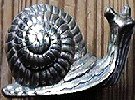 |
Cognac Passion La Lettre de La Cagouille de Gérard Allemandou |
| Number 1 Volume 3 | All reproductions prohibited. © 1997 Gérard Allemandou. English translation: Maggy Vincent |
 |
Cognac Passion La Lettre de La Cagouille de Gérard Allemandou |
| Number 1 Volume 3 | All reproductions prohibited. © 1997 Gérard Allemandou. English translation: Maggy Vincent |
|
A-propos Gilbert Delos has written a new book published by Hatier: "Le Monde du Cognac" (the World of Cognac). Considering the scarcity of books written about it, I am quite pleased with this publication remarkably illustrated with photographs by Matthieu Prier and Jean-Marc Lalier. The general review of the product and its region is covered short and to the point and that leaves a lot of consideration for a list of producers, vinegrowers and merchants. I am not trying to suggest that Gert v. Paczensky's "Cognac" is exhaustive, but the collective work directed by Frédérique Crestin-Billet, whose pen name is Gilbert Delos, describes the choices well. I especially like this selection since it includes new firms. Those firms attempt to carve out a place in the market with some success. No matter what their size or structure, whether they are vinegrowers or merchants, they compete efficiently with well established Cognac houses. This selection is really worth noting as it give boost to their efforts. This book would be perfect if it came out with tasting sessions grading for the mentioned products. They are numerous and this would prove certain vitality in spite of an obvious crisis in the Cognac industry. In addition, the amateur would find guidance to Cognac purchases. ±±±±±±± On Tuesday, 29th of April 1997, the Loudmer company organized a sale of wines and spirits at the Hôtel Drouot in Paris. Cognac was scarce as usual. It was represented by 3 bottles of which only one was original. Number 48 was called "Cognac 1845 Philippe Rivière 1000F+ pour le lot". The catalogue did not say that this bottle came from a 100 bottles batch which belonged to the Rivière family's inheritance scattered by Philippe Rivière some twent years ago. It wore no capsule and it was hand-labeled with the following mention: "les Gatinauds** chez Ballon 1845". It really is a Petite Champagne, collected on a piece of land called "chez Ballon", planted with Colombard and situated right in front of the family house; it rested more than fifty years in an oak cask in the Gatinauds' "chai". What mysterious path did it follow to go astray and then end up at this sale? Maybe one day I will be able to tell you about it. Coup de Coeur - Dégustation Antique de HINE As soon as one leans over the glass, a great fineness rises with a subtle, overwhelming softness. An old eau de vie unveils its charms when time has allowed it to develop elegance and class. The assemblage slowly shows through, letting younger flavors appear: they are less mature, almost arrogant. As time passes by, one or the other facets take their turn to take over, sometimes fine rank taste, sometimes powerful vanilla. Once in the mouth, the fruit softly acquires power in a pleasant blend, even if sometimes there remains a touch of sharpness. This eau de vie coats the palate and calmly gains strength with time. A good Fine Champagne.
Single or blended - Cognac cru ou assemblé? In order to be able to define quality, it is necessary to clarify this difference with precision. History says that a decree dating back to 1st May 1909 established the limits of the Cognac producing region. It was subdivided into seven "terroirs" (soils): Grande Champagne, Petite Champagne, Borderies, Fins Bois, Bons Bois and Bois à Terroirs. Each geographical area corresponds to a vineyard with very specific qualities. They are called "Cognac cru". The Bureau National Interprofessional du Cognac (BNIC) gives the following definition: "We must remind everyone that Cognac is the result of a composition marrying in harmony eaux de vie coming from different areas of the limited region". It is called "assemblage" (blending). The word "fine" can only be used for an eau de vie with a label of origin. Fine de Champagne, as decreed on 13th January 1938, is a blending of Petite and Grande Champagne eaux de vie. The proportion of Grande Champagne being a minimum of 50%. Nevertheless, the word "fine" can be associated with each one of the "terroirs": Fine Grande Champagne is actually a synonym for Grande Champagne, or Fine Fins Bois a synonym of Fins Bois. Over and above the demands of commerce, legal definitions, real and invented tradition and true or settled habits, it is my opinion that the difference between the two concepts remain essential. Blending (assemblage) can only lower the quality of the best eaux de vie entering its composition. it is not a determining quality factor. I always think a Cognac de cru is a superior to the best of blends. Would you find it logical to blend a Margaux with a Petrus? La Mouline is superior to la Côte Rôtie Brune or Blonde. Yet, I admit the difference between the products is necessary. An assemblage (blending) can be handled properly, especially when it must meet with a certain demand in quantity. but I do not think the trade promoting assemblage (blending) only is a good policy to support the quality of Cognac. To be continued... |
For your file: Thomas Hine et Co. 16 quai Orangerie, 16120 Jarnac Phone: (+33) 05 45 35 59 59 Fax: (+33) 05 45 81 63 98 Telex: 790469
|
| Cognac | Pineau des Charentes | Armagnac | Brandy |
| Buy on Internet | Vin de Pays Charentais | Hotel Restaurants | Tourism |
| www.swfrance.com | www.cognacnet.com | C03 May 1999 Copyright © 2000 Lusina ISG, Inc. | Torula News |